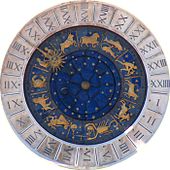Gemini (astrology)
| Gemini | |
|---|---|
 | |
| Zodiac symbol | Twins |
| Duration (tropical, western) | May 20 – June 20 (2024, UT1)[1] |
| Constellation | Gemini |
| Zodiac element | Air |
| Zodiac quality | Mutable |
| Sign ruler | Mercury |
| Detriment | Jupiter |
| Exaltation | North Node |
| Fall | South Node |
| Astrology |
|---|
 |
| Background |
| Traditions |
| Branches |
| Astrological signs |
| Symbols |
Gemini (pronunciation: /ˈdʒɛmɪnaɪ/ JEM-in-eye (♊︎)[2] is the third astrological sign in the zodiac, originating from the constellation of Gemini. It is a positive mutable sign. Under the tropical zodiac, the sun transits this sign between about 21 May and 21 June. [3] Gemini is represented by the twins Castor and Pollux,[4] known as the Dioscuri.
Astrology
This section may be too technical for most readers to understand. (June 2019) |
Taking from the twins that represent it, Gemini is considered by astrologists as one of the most important of the zodiacs since it captures someone's most basic "levels."[5] For instance, it articulates their dual nature, a species with the so-called lower self and higher self as well as the way they are bilaterally symmetrical.[5] Gemini is also considered by astrology followers as the most adaptable sign of the zodiac owing to the so-called mutable energy that allows individuals within this sign the so-called capability to view life from different angles.[6]
Other
NASA named its two-person space capsule Project Gemini after the zodiac sign because the spacecraft could carry two astronauts.[7]
Gallery
-
From the medieval Georgian manuscript of a 12th-century astrological treatise
-
Ornamentation from an altar cloth from 13th-century Germany. The two figures are depicted with the heads of dogs.
-
Gemini (al-Gawzaa) depicted in the 14th/15th-century Arabic astrology text Book of Wonders
-
Gemini by Willem Blaeu, 1602
Notes
- ^ Astronomical Applications Department 2011.
- ^ Unicode Consortium 2015.
- ^ Britannica n.d.
- ^ Oxford 2018, entries for Gemini and Cancer.
- ^ a b Baker 2016.
- ^ Tierney 2001, p. 81.
- ^ "Humans in Space | National Air and Space Museum". airandspace.si.edu. Retrieved May 15, 2020.
Works cited
- Astronomical Applications Department (2011). Multiyear Computer Interactive Almanac. 2.2.2. Washington DC: US Naval Observatory.
{{citation}}: Invalid|ref=harv(help) Longitude of Sun, apparent geocentric ecliptic of date, interpolated to find time of crossing 0°, 30°.... - Atsma, Aaron J. (c. 2015). "DIOSCURI : Greek Gods of Horsemanship, Protectors of Sailors | Mythology, Dioskouroi, w/ pictures". Theoi. Retrieved September 23, 2016.
{{cite web}}: Invalid|ref=harv(help) - Baker, Douglas M. (April 26, 2016). Gemini - The Key to Your Inner Self. Claregate Ltd. ISBN 9781910228142.
{{cite book}}: Invalid|ref=harv(help) - "English Oxford Living Dictionary". Oxford University Press. 2018.
- "Gemini". Encyclopedia Britannica. n.d. Retrieved June 24, 2020.
- Tierney, Bil (2001). All Around the Zodiac: Exploring Astrology's Twelve Signs. St. Paul, Minnesota: Llewellyn Worldwide. p. 81. ISBN 0738701114.
{{cite book}}: Invalid|ref=harv(help) - Unicode Consortium (2015). "Unicode 8.0 Character Code Charts" (PDF). Retrieved April 21, 2016.
{{cite web}}: Invalid|ref=harv(help)





